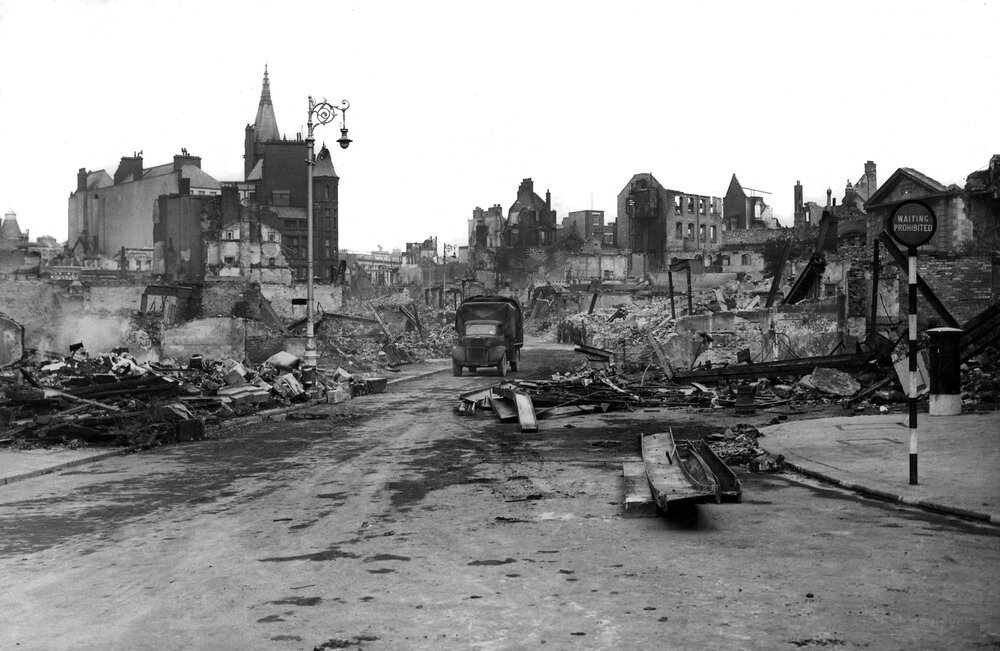Plymouth Blitz: The relevance of a UXO Desktop survey to Plymouth and other ports along the UK’s South Coast
The risk of encountering unexploded ordnance (UXO) in the UK as a result of World War II is not limited to London. Through a series of posts, Artios looks at the potential of UXO contamination at different locations across the UK.
This picture, taken 30th April 1941, shows the devastated heart of Plymouth. The gutted remains of the Guildhall is visible in the middle distance. The road in the foreground is believed to be Bedford Street.
The year 2021 saw the Plymouth City Council put on a series of events to commemorate the 80th anniversary of the Plymouth Blitz. The events, held in March and April 2021, reminded us that although London experienced the highest bombing density during WW2, many other cities around the UK were also devastated by attacks.
The knock-on effects of such attacks are still having an impact today. For example, for the construction industry the outcome of finding Unexploded Ordnance (UXO) could range from major delays to fatal occurrences. This is one of the reasons why it is so important to manage the UXO risk using the the four stage process provided by CIRIA C681 – Unexploded Ordnance.
What happened in Plymouth?
The National Collection of Aerial Photographs (NCAP) hold many aerial reconnaissance photographs taken of the UK by the Luftwaffe during WW2. This photograph shows RAF Roborough and Crownhill Fort to the North of Plymouth, which also suffered from wartime bombing.
1,174 civilians died during 59 separate bombing raids which took place between 6 July 1940 and 30 April 1944, with the vast majority of those deaths occurring in March and April 1941. Although the Royal docks at Her Majesty’s Naval Base, Devonport, were the main target, much of the city was razed to the ground during the attacks, with 2 main shopping centres, 26 schools, 41 churches, 1,900 public houses and 22,143 homes affected, with many completely destroyed.
Why Plymouth?
One of the longest continuous military campaigns of WW2 was the so called Battle of the Atlantic. This campaign involved thousands of ships, hundreds of battles and covered millions of square miles of ocean. The main reason for this campaign was to control the Atlantic shipping lanes, which were vital in sending military equipment and supplies from North America to Great Britain. Had this battle been lost the course of history would have been dramatically different, as Britain may have been starved into submission and ill-equipped to fight the war.
Initially, the major Naval Base in Plymouth served as the British Headquarters for the Battle of the Atlantic. This was later moved in 1940 to Liverpool. However, Plymouth was, and continued to be a major supplier of ships for the Battle of the Atlantic, D-day and many other naval battles. This meant that it was a key target for the Germans. Once Germany had successfully invaded France they were able to launch effective air raids on Plymouth with relative ease, and dismissed the assumption that the distance of Plymouth from German airfields would provide a measure of safety.
An excerpt from the Plymouth Blitz Bomb Book showing an accurate plotting of wartime bomb strikes across the city. Compiled during WW2 by the Town Clerk’s Department, it can be seen on display at the ‘The Box’ Museum, Plymouth.
Post-war reconstruction
One of the factors that can reduce the risk of finding UXO on a construction site is the extent of post war development on the site. Intrusive works undertaken at a site post WW2 may have removed any UXO present, provided confirmed evidence that contamination is present or indeed giving confidence that it is not.
Bomb damage in Plymouth following a raid in the Blitz, taken on the 12th April 1941.
With much of Plymouth destroyed by the end of WW2 extensive reconstruction was required, and indeed in many places brand new buildings were constructed. Following tours, consultations, and thorough analysis of the area a ‘Plan for Plymouth’ was published in 1944 by Sir Patrick Abercrombie, the leading town planner of the day, in conjunction with the City engineer James Patron Watson. This bold plan looked to completely redesign Plymouth, including a brand new city centre and thirteen brand new housing estates as well as ring-roads, bypasses and more.
Work began on the city centre in 1947 with the construction of the Royal Parade. Construction continued for years to come using the Plan for Plymouth as a guide for individual owners and developers to work from. The opening of the Tamar Bridge in 1962 is widely considered to be the end of Plymouth’s post war reconstruction, with further works being seen as normal city development.
Relevance of a UXO Desktop survey
It is important to be aware of what post-war construction, if any, has taken place on a development site, as well as what that construction may have unearthed and indeed the sub-surface level that was reached. Without this knowledge, the risks of encountering UXO is unknown and potentially costly and fatal.
An impartial Preliminary, and if required, Detailed UXO Risk Assessment will provide confidence that the UXO risk is managed safely, effectively and efficiently.




